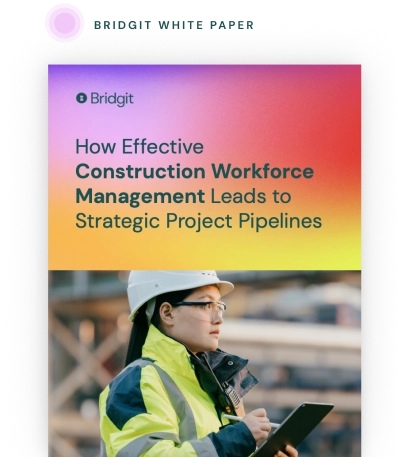Winning bids at a high rate is one of the lifelines to maintaining a construction company. While this is a simple concept, being successful at it requires a general contractor capable of juggling many variables, some of which are completely out of their control. Some of these variables are finding quality leads, selecting the right projects to bid on, reviewing profitability, dozens of hours of due diligence, identifying and managing risks, calculating and reliably predicting the costs of material and labor, and finding the right subcontractors.
Adding labor shortages caused by unpredictable events like the pandemic and the pessimistic economic forecast for at least the next year, it’s impressive that operations leaders can accomplish so much with manual processes like spreadsheets. It’s more important than ever that GCs upgrade their predictive power in as many facets of their business as possible.
One of the key variables in winning bids is having a strategically planned workforce so that you can find and fix the limitations that go along with it. In a survey done by Bridgit, 40% of the GCs surveyed said they would win more bids if they could better predict workforce requirements and limitations.
Table of Contents
These limitations go beyond knowing if you have the available labor to take on a project; they could also be the experience and skills of your team for certain types of jobs.
Interesting stats on project bidding
Outlining the significance of the problem of poor workforce planning is important because it demonstrates the scale of the issue. In the same survey done by Bridgit, 70% of GCs said they allocate staff to projects less than two months in advance. Additionally, 46% said they don’t have adequate time to hire staff when the project needs it. This makes for a reactive situation.
As work piles up, contractors are put in a position where they have to rush, leading to mistakes like hiring the wrong people for the job or spending more money on experienced labor that costs more. You may also have to pull people from other jobs, which causes delays in your current work and hinders your ability to win jobs in the future.
About 86% of those surveyed said they’ve bid on projects only to find they don’t have the proper workforce to complete the job. This alarming statistic points to the difficulty of predicting and planning labor. It also demonstrates that GCs aren’t bidding on work in the most informed way possible.
Putting together a bid has an overhead cost, whether won or lost. These costs include marketing, sales, pre-construction services, public relations, and employing estimators. By going into uninformed negotiations about something as significant as labor, you’ll lose opportunities at a high cost.

Use your workforce data to create a competitive advantage
Download our white paper to see how effective workforce planning can help stay ahead of labor demands and create a strategic project pipeline.
What does this mean for general contractors?
There’s an asymmetry between the reality of the situation and the data GCs are drawing their decisions from. Of course, GCs don’t just come up with things out of thin air; their decisions are based on their data, and that’s where the problem lies.
Getting good-quality data is harder than it seems. It’s not necessarily the GC’s fault for being unable to do so. They’ve been tasked with solving extremely complex problems with only increasing complexity of projects. The tools needed by GCs to solve these problems have to account for, predict, and model scenarios with dozens of moving parts involving numerous stakeholders. Ideally, these stakeholders should have visibility across these scenarios and the ability to collaborate on solutions to problems proactively and as they appear.
Since GCs use a lot of manual processes like spreadsheets to plan their workforces, their data eventually gets siloed. Either one person controls the spreadsheet, it’s outdated, or it breaks due to bad incoming data. This process results in a lack of visibility on your capacity to do more work.
Fewer mistakes, not bigger wins
Winning a large project as a GC is something to be excited about, but if your workforce is limited, this may mean higher costs than you’re willing to handle. You may want to think about winning right instead of winning big.
What does winning right mean? It means taking on the right projects for your company and bidding on projects you have a higher chance of winning and completing successfully. Your bid-hit ratio could point to the fact you’re making fewer mistakes.
“Your bid-hit ratio is the winning rate at which you successfully bid or propose on construction projects”. For example, a 5:1 bid-hit ratio means for every five projects you bid on, you’re awarded one. A lower ratio is ideal, but this varies from company to company.
A significant portion of the reactivity in construction could be mitigated with increased visibility into a GC’s workforce. Being able to forecast months or years in advance would provide a chance to deal with short-term problems on the site without worrying if people can get on it in the first place.
Knowing if you can take on a project and being confident in the data would allow you to strategically bid on projects that give you a higher chance of winning. As this data and collaboration improve, you will be more efficient at distributing resources where needed.
What can I do to improve my ability to plan my workforce?
GCs need to be able to oscillate between seeing their work holistically and specifically. Unfortunately, the manual processes used to plan people now don’t do a great job of doing either. At this point, GCs should leverage technology to simplify workforce planning.
Leveraging technology for this purpose is a two-step process: you want a tool that houses the information on your people and projects, and you want your tools to be integrated to import and export data smoothly. Not only will the integrity of your data be better, but you’ll also save time by avoiding double data entry. This is called a “common data strategy”; it helps make informed staffing decisions and improves the predictability of your business. As predictability increases so do your chances of winning a bid since you’ll be bidding on projects with the highest chance of winning. Winning means growth, and growth means bigger wins over time.


